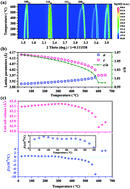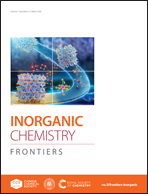Negative thermal expansion and the role of hybridization in perovskite-type PbTiO3-Bi(Cu0.5Ti0.5)O3†
Abstract
PbTiO3-BiMeO3 ferroelectrics have attracted much attention due to not only their extremely large polarization and piezoelectricity but also their controllable thermal expansion. In this study, we present a new binary system of (1 − x)PbTiO3-xBi(Cu0.5Ti0.5)O3 possessing large tetragonality and enhanced spontaneous polarization. Interestingly, a combination of near zero thermal expansion and negative thermal expansion over a temperature range of RT to TC (∼550 °C) has been observed in tetragonal 0.85PbTiO3-0.15Bi(Cu0.5Ti0.5)O3. The comprehensive structure analysis addressed that the abnormal thermal expansion is coupled to the spontaneous volume ferroelectrostriction. Moreover, the chemical bonding investigation by a maximum entropy method further attests that the covalent hybridization of Pb/Bi–O bonds plays a vital role in the improved ferroelectricity and interacts with thermal vibration to dominate the crossover from positive to negative thermal expansion. The present studies would give direct evidence to verify the theoretical calculations and could be extended to reveal the nature of thermal expansion in ferroelectrics.



 Please wait while we load your content...
Please wait while we load your content...